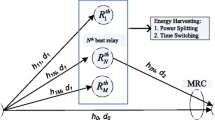Abstract
In this paper, co-channel interferences are exploited for energy harvesting in a Cooperative Network (CICN) in which a power constrained relay uses a power splitting architecture (CICN-PS) and a time switching architecture (CICN-TS) to harvest energy from the radio-frequency signals received from a source node and co-channel interferences. In the proposed CICN-PS and CICN-TS protocols, the relay applies decode-and-forward technology to decode the information of the source node, and then forwards the recoded information to a destination with the overall harvested energies. The system performance of the proposed protocols is discussed and evaluated using the exact throughput analyses and is then checked using Monte Carlo simulations over Rayleigh fading channels. The optimal power splitting ratio and energy harvesting time are derived by the Golden Section Search method, and throughput performance evaluations are performed. Our numerical and simulation results show distributions as follows. Firstly, the CICN-PS protocol outperforms the CICN-TS protocol. Secondly, the proposed protocols strictly depend on the location, amount and power of the co-channel interferences. Thirdly, when signal-to-noise ratio increases, the proposed CICN-PS protocol achieves the perfect throughputs where the cooperative relay applies the ideal receiver and co-channel interferences do not affect the destination. Finally, the numerical analyses agree well with the simulation results.










Similar content being viewed by others
References
Raghunathan, V., Ganeriwal, S., & Srivastava, M. (2006). Emerging techniques for long lived wireless sensor networks. IEEE Communications Magazine, 44, 108–114.
Paradiso, J., & Starner, T. (2005). Energy scavenging for mobile and wireless electronics. IEEE Pervasive Computing, 4, 18–27.
Varshney, L. R. (2008). Transporting information and energy simultaneously. IEEE international symposium on information theory (ISIT 2008) 2008, pp. 1612–1616.
Zhou, X., Zhang, R., & Ho, C. K. (2013). Wireless information and power transfer: Architecture design and rate-energy tradeoff. IEEE Transactions on Communications, 61, 4754–4767.
Nasir, A. A., Xiangyun, Z., Durrani, S., & Kennedy, R. A. (2013). Relaying protocols for wireless energy harvesting and information processing. IEEE Transactions on Wireless Communications, 12, 3622–3636.
Zhiguo, D., Perlaza, S. M., Esnaola, I., & Poor, H. V. (2014). Power allocation strategies in energy harvesting wireless cooperative networks. IEEE Transactions on Wireless Communications, 13, 846–860.
Yanju, G., & Aissa, S. (2014). Interference aided energy harvesting in decode-and-forward relaying systems. IEEE International Conference on Communications, 2014 (ICC 2014), pp. 5378–5382.
Zhao, S., Li, Q., Zhang, Q., & Qin, J. (2015). Optimal secure relay beamforming for non-regenerative multi-relay networks with energy harvesting constraint. Wireless Personal Communications (WPC), 85, 2355–2365.
Ahmed, I., Hossain, M. J., & Ahmed, I. (2015). Resource allocation for decode-and-forward relayed system with interference aided energy harvesting. IEEE international conference on ubiquitous wireless broadband, 2015 (ICUWB 2015), pp. 1–5.
Chen, Y. (2016). Energy-harvesting AF relaying in the presence of interference and Nakagami-m fading. IEEE Transactions on Wireless Communications, 15, 1008–1017.
Nguyen, S. Q., & Kong, H. Y. (2015). Outage performance and diversity analysis of cognitive triple-hop cluster-based networks under interference constraint. Wireless Personal Communications (WPC), 85, 1669–1688.
Nosratinia, A., Hunter, T. E., & Hedayat, A. (2004). Cooperative communication in wireless networks. IEEE Communications Magazine, 42, 74–80.
Duy, T. T., & Kong, H. Y. (2014). Adaptive cooperative decode-and-forward transmission with power allocation under interference constraint. Wireless Personal Communications (WPC), 74, 401–414.
Nguyen, S. Q., & Kong, H. Y. (2016). Outage probability analysis in dual-hop vehicular networks with the assistance of multiple access points and vehicle nodes. Wireless Personal Communications, 87, 1175–1190.
Tourki, K., Qaraqe, K. A., & Alouini, M. S. (2013). Outage analysis for underlay cognitive networks using incremental regenerative relaying. IEEE Transactions on Vehicular Technology, 62, 721–734.
Ding, H., Ge, J., da Costa, D. B., & Zhuoqin, J. (2011). Asymptotic analysis of cooperative diversity systems with relay selection in a spectrum-sharing scenario. IEEE Transactions on Vehicular Technology, 60, 457–472.
Zhihang, Y., & Il-Min, K. (2009). Relay ordering in a multi-hop cooperative diversity network. IEEE Transactions on Communications, 57, 2590–2596.
Son, P. N., Har, D., & Kong, H. Y. (2015). Smart power allocation for secrecy transmission in reciprocally cooperative spectrum sharing. IEEE Transactions on Vehicular Technology, 64, 5395–5400.
Duy, T. T., & Kong, H. Y. (2012). Exact outage probability of cognitive two-way relaying scheme with opportunistic relay selection under interference constraint. IET Communications, 6, 2750–2759.
Liang, L., Rui, Z., & Kee-Chaing, C. (2013). Wireless information transfer with opportunistic energy harvesting. IEEE Transactions on Wireless Communications, 12, 288–300.
Yang, L., Qaraqe, K., Serpedin, E., & Alouini, M.-S. (2013). Performance analysis of amplify-and-forward two-way relaying with co-channel interference and channel estimation error. IEEE Transactions on Communications, 61, 2221–2231.
Gradshteyn, I. S., Ryzhik, I. M., Jeffrey, A., & Zwillinger, D. (2007). Table of integral, series and products (7th ed.). Amsterdam: Elsevier.
Chong, E. K. P., & Zak, S. H. (2001). An introduction to optimization (2nd ed.). New York: Wiley.
Acknowledgements
This research is funded by Vietnam National University Ho Chi Minh City (VNU-HCM) under grant number B2017-20-04.
Author information
Authors and Affiliations
Corresponding author
Appendix: Proof of Lemma 1
Appendix: Proof of Lemma 1
The joint CDF of RV Y and the condition \({g_1} \ge {u_1} + \phi {\gamma _t}{X_3}\) is expressed as
We see easily that \({F_{Y,{g_1} \ge {u_1} + \phi {\gamma _t}{X_3}}}\left( y \right) = 0\) when \(y \le {u_1}\).
When \(y > {u_1}, {F_{Y,{g_1} \ge {u_1} + \phi {\gamma _t}{X_3}}}\left( y \right) \) in (40) is obtained as
Substituting (23) into (41), \({F_{Y,{g_1} \ge {u_1} + \phi {\gamma _t}{X_3}}}\left( y \right) \) is solved as
where \(\varGamma \left\{ {a,z} \right\} \) is the incomplete gamma function, \(\varGamma \left\{ {a,z} \right\} = \int \limits _z^\infty {{t^{a - 1}} \times {e^{ - t}}dt} \), [22, Eq. (8.350.2)].
Hence, Lemma 1 is completely proven.
Rights and permissions
About this article
Cite this article
Son, P.N., Kong, H.Y. Co-channel Interference Energy Harvesting for Decode-and-Forward Relaying. Wireless Pers Commun 95, 3629–3652 (2017). https://doi.org/10.1007/s11277-017-4017-6
Published:
Issue Date:
DOI: https://doi.org/10.1007/s11277-017-4017-6




